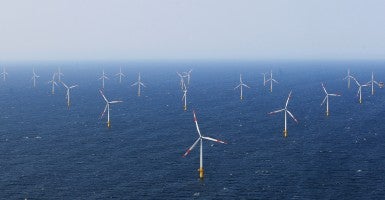The potential collapse of a controversial project off the coast of Cape Cod, Mass., is blowing some doubt around the future of offshore wind energy in the United States.
Earlier this month, the Cape Wind project — calling for construction of 130 wind turbines off the coast of Nantucket Island to supply electricity to the area at a cost of $2.5 billion — appeared dead in the water after energy companies NSTAR and National Grid announced they are backing out of their contracts to purchase electricity from Cape Wind.
Without financing from its two biggest customers, the project that has drawn criticism from environmentalists as well as fiscal conservatives may not continue, even though it’s been debated for more than 13 years.
“It’s a nonstarter, particularly on cost-benefit grounds and on economic and environmental issues,” said David Tuerck, executive director at the Beacon Hill Institute and economics professor at Boston’s Suffolk University.
But the potential collapse of Cape Wind brings up larger questions about the ability of offshore wind energy projects to get a foothold in the U.S.
“I do think that it slows things down,” said Susan Tierney, a former assistant secretary for policy at the U.S. Department of Energy who is now a consultant in Boston and worked with Cape Wind officials. “It may give a lift to opponents who feel emboldened to keep pounding on things and it may chill some developers who might otherwise really want to do it.”
Unlike land-based wind farms, which have been constructed in large numbers in states ranging from Texas to California to Iowa, offshore wind projects require underwater transmission lines that connect turbines to power grids on land. As a result, offshore projects can cost up to three times more than onshore projects.
“I think offshore wind energy projects in the United States are dead for the foreseeable future,” said Tuerck, a longtime critic of the Cape Wind project. “With the declining fossil fuel prices and the demonstration by Cape Wind about how expensive offshore wind power is, I think it’s dead for the foreseeable future.”
With Cape Wind on the sidelines, it appears the most likely candidate for the first functioning offshore wind farm in the country will go to DeepWater Wind, a $225 million project off the coast of Block Island in Rhode Island.
DeepWater Wind CEO Jeffrey Grybowski told the Rhode Island’s Public Utilities Commission recently the project is on schedule and should be up and running by the end of 2016.
Grybowski also said the project could produce more power than originally expected, which could drive down electricity bills.
But some question whether the project will prove a good use of taxpayer dollars.
“As to whether this is a real project that would justify the costs of the increase in utility rates,” state Rep. Robert Craven, D-North Kingstown told WJAR-TV, “people in Rhode Island are mad about that.”
Farther south, Dominion Virginia Power is looking to develop an offshore wind project in federal waters off the coast of Virginia Beach.
Offshore wind energy projects are common in Europe, numbering more than 2,000 commercial turbines in 11 countries. Supporters say they’re good for the environment and can reliably supply electricity to customers.
Last week, wind energy officials in Germany announced the country’s 258 offshore turbines surpassed 1 gigawatt of capacity for the first time.
The debate over offshore wind projects is coming at a pivotal time.
Just before the end of 2014, Congress extended the wind energy production tax credit — but only through the end of the year.
Update 1/20: Bloomberg News BNA, quoting an analyst who said “I think they feel like the handwriting is on the wall,” reported the wind industry “is lobbying for a gradual phaseout of its production tax credit as it faces the reality that an increasingly skeptical Republican-controlled Congress may choose to let the lucrative incentive remain expired.”
The tax credit is dismissed by critics as a boondoggle, but seen by supporters as crucial to keeping the wind energy industry going.
Billionaire Warren Buffett said in 2014 that he uses wind energy essentially as a tax write-off for his Berkshire Hathaway conglomerate.
“We get a tax credit if we build a lot of wind farms,” he told an audience in Nebraska. “That’s the only reason to build them.”
“What you have to keep in mind is that without production tax credits, there is no wind power in the United States,” Beacon Hill’s Tuerck said. “It has to be subsidized anywhere around the world it’s done … It doesn’t have to be subsidized if government is willing to make ratepayers pay more for their energy but it is simply more expensive to produce energy by wind than it is by natural gas, coal or oil.”
But with environmental concerns in mind, supporters say they’re confident that offshore wind projects will happen sooner rather than later in the U.S.
“The United States has a tremendously rich offshore resource,” Tierney told Watchdog.org in a telephone interview. “Not just off the East Coast, but off the Great Lakes and parts of the West Coast … I think it’s something at some point we’re going to have to turn to.”






























